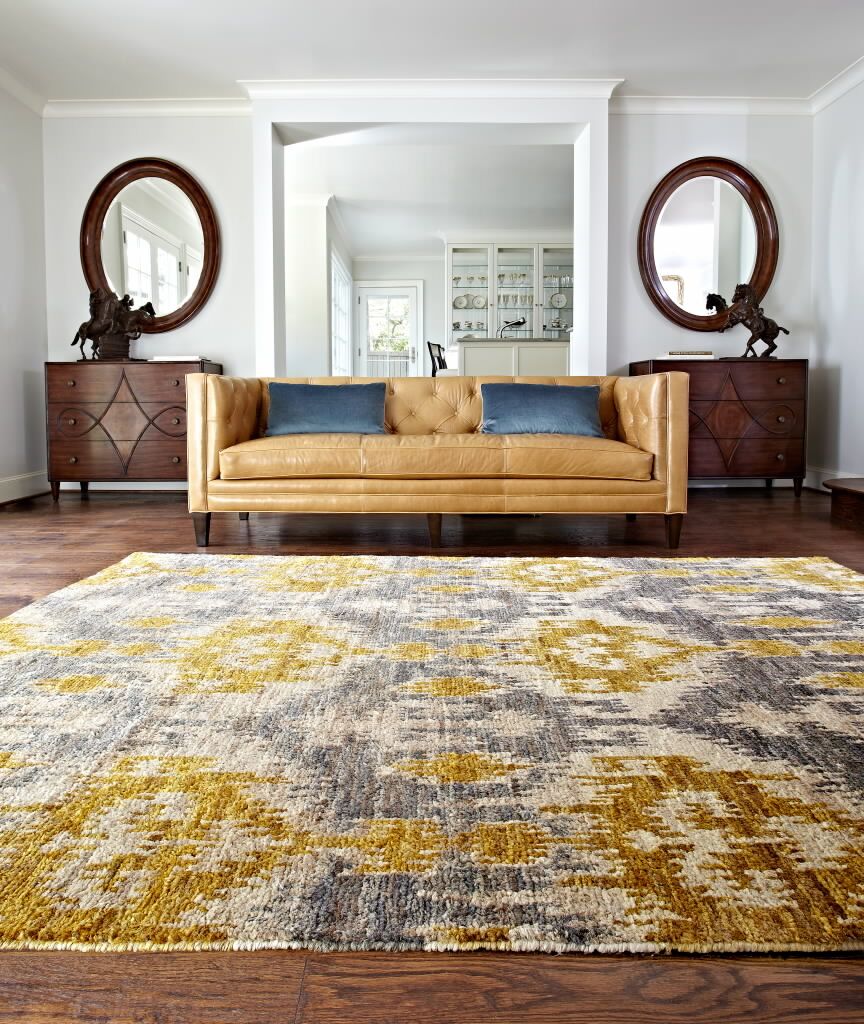Your Cart is Empty
Wilsonville Showroom Closing - Final Days!
Wilsonville Showroom Closing - Final Days!
RUGS
FURNITURE
LOCATIONS
The Essence of Design, Part 3 - Material, Textures, and Patterns

In Part 1 and Part 2 of this series, we introduced the importance of establishing what sort of space you’re working with, the purpose for the room you’re designing, setting a theme that will tie your elements together, and how you can use color theory to find a palette that will fit your theme.
In today’s post, we’ll be discussing different materials, textures, and patterns, and how they are not only important for enhancing the emotions you’ve established in your theme, but also for helping support your room’s purpose.
The Importance of Material
One of the most important, but often overlooked, factors to consider when choosing furniture and decor, especially rugs, is material selection. Often, color and price are the two factors that most people will weigh before making a selection. They barely consider what the piece is made of, if they consider it at all.
While I understand the rational, the reality is that material selection can play just as critical a role as any other in separating a livable space from a masterpiece that anyone would be proud to call their own. Material is also an important consideration for increasing the longevity of your purchase and supporting the purpose of the room you’re designing. Finally, material can play a large role in adding depth to your design.

Types of Materials
Before we can start discussing how to go about picking the best material, we need to identify some of the common materials used to craft the best pieces, and the characteristics of each one.
Wool
Wool is far and away one of the most popular materials, and with good reason! Gracing everything from rugs to cushions, wool is a thick, durable material, that easily repels stains and has a long life. Wool tends to retain its form over time, and is easy to dye, while also being incredibly comfortable. The only real disadvantages of wool is that it tends to shed, and should only be cleaned by a professional to maintain it properly.
Cotton
Cotton is a soft, pliable material, that can easily take on a wide spectrum of different colors. Most cotton materials are safe for machine and hand-washing at home. Cotton tends to have a plain, more homely look that fits well in many themes and color palettes and tends to be less expensive than other materials. However, cotton can also damage easily, and tends to have a shorter lifespan.
Jute and Sisal
These are tough, pliable materials that can stand the test of time, and endure even the roughest treatment. Jute and sisal allow for unique weaves and textures that aren’t possible with other materials, and do not stimulate allergies. However, these are rough, course materials that aren’t very comfortable for feet, and stain easily due to absorbing moisture easily.
Nylon
Nylon is a synthetic material that is durable, versatile, and available in a nearly endless variety of colors. Nylon has a soft, silk-like appearance that can lend a beautiful radiance to any room, and it is very easy to clean. However, nylon has to be dyed acidically, which can lead to fading over time.
Polyester
A popular synthetic material used in a wide variety of furniture pieces, polyester is colored with solutions, and so it is very resilient against bleach, fade, and abuse. However, polyester is difficult to dye, and so color options are often limited.
This is only a small selection of the dozens of materials used. Even from this short list, you can see that the characteristics vary widely based on material. For this reason, a setting that will work beautifully with one material, will lead to disaster with another.
How then do you choose a material that will not only fit well in your theme, but also fit naturally within the setting of your room?
Tying Material to Purpose
Just as we must decide our purpose before we can settle on a theme, we have to choose a material that will fit our setting before we can settle on appearance.
To illustrate how you can approach material selection, let’s consider two different rooms, with two completely different purposes: a children’s playroom, and an in-home office.
With a children’s playroom, you know that your kids are going to be walking, rolling, and potentially spilling food and drinks. You’ll need a material that can stand up to anything your children can throw at it, but also be soft and supportive as they tumble around. In this case, wool or nylon would make an excellent choice.
By contrast, an in-home office is a room that may see little physical activity but serves as a sanctum for concentration and mental effort. Since shoes are optional in spaces like this, and you probably won’t be doing a lot of eating or drinking here, a comfortable material that won’t see much abuse, such as cotton or polyester, would be an excellent choice.
The environment you live in also plays a key role in determining the best material for you. Wool, for a example, is very thick and insulates heat well, meaning you can reduce your energy costs by keeping the heater at a lower setting. Conversely, cotton is a very breathable material that allows air to flow freely, making it perfect in higher temperatures.

How Texture and Patterns Can Transform a Room
While it’s best that you begin your selection based on material, it doesn’t end there. Just as color is critical in realizing a theme and conveying emotion, different textures can tie in with your color selection to truly elevate a room to a work of art.
When we discussed choosing a theme in Part 1, most of the focus went towards the emotional impact, tied in with the space we would need and supporting a purpose. However, another element you can focus on in a theme is style.
There are any number of styles that you can choose, from contemporary to rustic, art deco to modern, vintage to exotic. Settling on a style that fits your theme can also make your furniture selection process easier, since many pieces are designed around a particular style, and will fit together naturally.
However, I want you to understand how textures and patterns can directly influence a mood. If you decide that you want to mix and match from different styles and collections, you’ll understand the basic philosophy behind these factors, which will help you make a better decision.
What Makes Textures and Patterns?
Texture, in layman’s terms, is the visual appearance of an object that suggests a certain physical characteristic; i.e., “it looks the way it feels.” When we look at cotton, it has a light, fluffy appearance, and that suggests that it will be soft and fairly fragile to touch. By contrast, jute and sisal has a woven, handmade texture that suggests a rougher but more resilient touch.
Texture is mostly the result of two factors - the material used, and the process used to make the piece. Depending on the combination, a wide variety of textures can emerge.
In that same train of thought, patterns emerge by taking a foundational shape, and then copying it or making slight variants throughout the piece. For example, diamonds are a common pattern that have remained a popular foundation for patterns for centuries.
How to Tie Texture and Patterns into Your Theme
Texture can suggest a certain mood or emotion by hinting at attitudes or a state of mind. Silk, for example, has a soft, glossy radiance that suggests luxury and extravagance, which can lead to feeling relaxed and catered too. Conversely, jute and sisal have a deliberate, handwoven texture, illustrating the high degree of mental resolve the weaver required to make each strand perfect. This can lead to feeling inspired or determined.
Patterns also feed into different emotions, depending on the shapes and repetition used. When you look at our collection of Pakistani rugs, there’s a wide variety of patterns to choose from, and each can serve a unique role in channeling emotion.
Some of the patterns are simple repetitions of ovals and octagons suggesting order and organization, which can help us feel us feel both secure and at ease. Other patterns in the collections are explosive bursts of color, with many variations on the same, ever-popular diamond shape, that suggest energy and drama, and can spur excitement and conversation.
Textures and patterns are also extremely useful in creating variety and heightening the engagement in a room. We discussed in Part 2 how a triadic color scheme is an effective starting point, and one technique you can use to make it fully blossom is to use your wall paint as the first color, your couches and chairs as the second, and your cushions and rugs as the third.
Textures and patterns don’t have to always match perfectly with your other pieces. They can mix in various ways to give your home a unique, hand-crafted flavor, or draw attention to the focal point of your room. However, be aware that mixing can result in a design that clashes, so it’s essential that you establish a common theme to tie your patterns together, before you decide to mix patterns.
It Looks How It Feels
I really appreciate you taking the time to read this post, and I hope that you enjoyed learning about materials, textures, and patterns! Though these elements often play second fiddle to other design elements, I hope you’ve come to realize that weighing them just as much as color or size can help design a room that both looks and feels beautiful and unique.
In our final post, we’ll use a case study from one of our own room designs to tie all of the design elements we’ve discussed into one example, with step-by-step explanations, to give you a solid reference as you begin your own design. Until then, I wish you all the best, and can’t wait to have you back!


